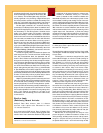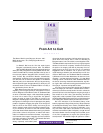
Kubrick’s Eyes Wide Shut
. . . . . . . . .
yes Wide Shut is one of those films that has the main-
stream movie reviewers (I don’t dare use the word crit-
ic in this context) in cloud cuckooland, with their
assessments reading more like Rorshachs than having much
to do with Stanley Kubrick’s last film. If you’ve seen the pic-
ture, reading the reviews can be a bucket of fun, especially if
you have an idea of what’s really going on in the film.
First of all, E y e s is a horror movie, and has more in com-
mon with The Shining than with any other Kubrick opus.
The Shining failed, finally, because Kubrick never success-
fully connected the ghost story with his hero’s descent into
madness. He is far too literal a director to hurl himself with
abandon into the conventions of a ghost story. And so you
get two-thirds of a great movie that, for all practical pur-
poses, ends when the “ghosts” let Jack Torrance out of the
food-storage room.
What The Shining is really about is the fragility of the
family and its susceptibility to attack. It fails because Kubrick
cannot correlate Jack Torrance’s inner demons with those
that exist independently of him or are functions of his own
subconscious projections. The Overlook Hotel represents the
ghosts of the past, and the ghost in Torrance’s past is the bot-
tle, which, of course, the ghosts are quick to provide (in the
form of Jack Daniel’s). The drinks, we may assume, are not
real, but the alcoholism – or its root cause – is, since it
unleashes his inner demons.
In Eyes, the family is once again under attack. And the
trigger is, once again, an external one – the wife (Kidman),
whose confession of a passing crush unleashes her
foursquare (doctor, played by Cruise) husband’s demons of
sexual jealousy and sends him on an Odyssey through New
York’s sexual underworld – a demimonde depicted in cool,
stylized, and, at its core, highly ritualized fashion. His preda-
tory curiosities, once evoked, threaten both him and his fam-
ily. Kubrick once again fails, and by a wider margin than he
did in The Shining, to correlate his mythic hero’s journey into
the underworld of the subconscious with the externals of his
life as we are shown them.
Making the connection with The Shining e x p l i c i t ,
Kubrick films a party sequence near the opening in much the
same fashion (and exactly the same colors) as he did the
haunted Ballroom sequences of the Overlook; he even plays
some of the same music. The party’s host is Sidney Pollack,
playing a corrupt Manhattan patient of Cruise; Pollack’s avun-
cular manner notwithstanding, he serves the function of
Charon in Cruise’s journey to the far shores of Hades. And it
is he who, toward the film’s end, will try to explain away much
of what has threatened Cruise as a “charade.”
The film’s central tableaux is a ceremonial sexual rite
(set in a mansion in Glen Cove, Long Island, which drew
huge laughs at the local theater) and it is more frightening
than anything in The Shining – with the possible exception
of the baseball bat sequence. All of the guests – Cruise
being the party crasher who is about to be exposed – are
dressed in cloaks and masks and resemble nothing less
than an army of c o m m e n d a t o r i from A m a d e u s. The music,
the chanting, the sepulchral spaces, and the mechanical,
stylized sexual couplings all suggest sexuality run rampant,
that is, sexuality without feeling. (One has to look no fur-
ther than the S&M community for insight on how the trap-
pings of sex become a substitute for love.) And sexuality
without love, that is, outside the family, Kubrick views with
p.c. heterosexual suspicion.
This sequence surely wasn’t meant to be pornographic or
sexy; it strips bare the intellectual threadbareness of the
MPAA and its consummate white-bread (and childish) fear of
sex. What Kubrick suggests, I would argue, is that this form of
sex is a form of death and that is why it was without anima-
tion – there was no need to cover up the soft-core behavior of
the mannequins. What the scene reveals is both the charac-
ter’s and the director’s fear of death, as represented by the
death of love. Indeed, what could be more explicit than the
offer of a young woman to stand in Cruise’s place once he is
discovered and about to be sentenced to death? She saves
him, and the next day he learns that she is really dead. Cruise,
of course, is way out of his depth here. He is surrounded by
vampires and he’s incapable, Top Gun-style, of showing the
slightest bit of fear (the horror of a big shot looking weak!).
Nor can he suggest layers of depth within the repressed doc-
tor, much less the presence of lusty subconscious urges; he
flirts more with a gay hotel clerk – a wonderful bit by Alan
Cumming of Cabaret– than with anyone else in the film, prob-
ably because he can be playful in this scene, freed from the
darker depths Kubrick may have wanted him to explore.
The ending is particularly unsatisfying. In a long, badly
played, clumsily staged scene, the Pollack character tries to
explain away the happenings of the evening before and the
threats on Cruise’s life as part of the stylized goings-on.
Instead of being ambiguously disturbing, it is just a mess, leav-
ing the audience to wonder. (Certain disturbing things are left
unaccounted for, including an explanation of how the mask
Cruise wore to the ball turns up on the pillow next to his
sleeping wife.) Whether the goings-on where real or a dream
– and they are played straight – the final word of the film,
uttered by Kidman, suggests the solution for the couple is to
go home and “fuck.”


















